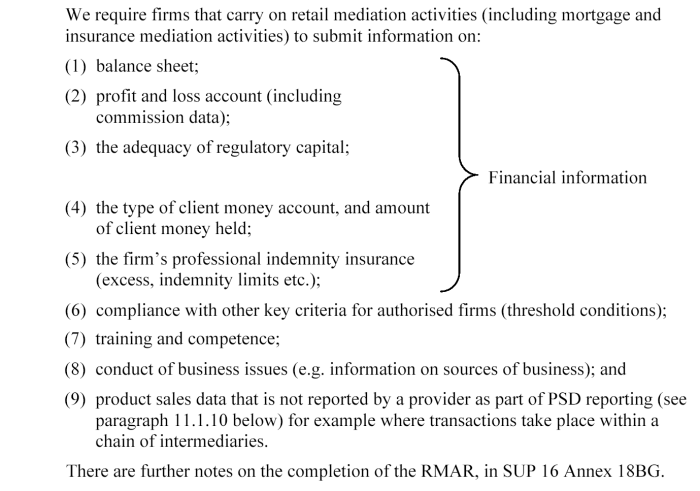MIGI 11.1 Reporting requirements
We require insurance and mortgage intermediaries to report certain information to us on a regular basis. Our rules relating to reporting requirements for mortgage and insurance intermediaries are in SUP 16.
Why do we require periodic information from firms?
We need to receive timely information from firms that carry on mortgage and insurance mediation activities so that we can effectively supervise them. The information we collect helps us to monitor firms' adherence to the threshold conditions (see Part I, paragraph 4.2.5) and specific rule requirements, and allows us to spot trends in individual firms and in the market as a whole. It also helps us to identify firms on which we should target supervisory attention.
How is information submitted?
The main reporting requirements for mortgage and insurance intermediaries are known as the Retail Mediation Activities Return (RMAR), which must be submitted electronically, using either:
- (1)
internet-based submission, where users will log in to the FSA's secure website area and complete forms online; or
- (2)
direct data submission, where a firm's system will connect directly to the FSA's system over a secure internet link.
The information requirements in the RMAR differ depending on firm type and the regulated activities carried on by a firm. This is to ensure that we only ask for information that is relevant to the supervision of each firm.
What information do you need to submit in the RMAR?
When and how often do I have to submit the RMAR?
RMAR reporting will not commence until 1 April 2005, even though firms will become authorised before this date. From 1 April 2005, we will require the RMAR to be submitted twice each year within 30 business days of the end of the relevant reporting period. The reporting periods are:
- (1)
the six months immediately following a firm's accounting reference date; and
- (2)
the six months immediately preceding a firm's accounting reference date.
Larger firms, defined as those with annual income of more than £5m in the previous year, will be required to submit the financial information sections every three months.
There is a transitional arrangement in place for smaller firms (defined as those with annual income of less than £60,000). For the first year this arrangement exempts these firms from the requirement to submit financial information at their financial year mid-point (making the financial reporting requirements annual rather than half yearly).
The reporting requirements are in SUP 16.7.76 R to SUP 16.7.81 G. SUP 16 Ann 18A contains a proforma of the RMAR and SUP 16 Ann 18B contains guidance notes to help you complete it.
Other reporting requirements
Your firm is also required to confirm each year, within 30 business days of its accounting reference date, that we have the correct 'standing data' for the firm (16.10.4R). A firm's standing data is the information in SUP 16 Annex 16 and includes, for example, the name and registered office of the firm, the regulated activities for which the firm has permission, the name and address of the firm's auditor (if applicable) and its accounting reference date. Your firm should check its standing data through the FSA website as explained at SUP 16.10.4 R to SUP 16.10.6. This requirement is in addition to the notification requirements set out in Part I, paragraph 11.2 below.
We also collect data (known as product sales data or 'PSD') on individual transactions in mortgages and pure protection products. However, this data is submitted by the product providers rather than the intermediary firms (see SUP 16.11 for details). This information enables us to:
- (1)
identify which intermediaries (and product providers) are selling particular types of product (so helping us target both our firm specific and our thematic work);
- (2)
identify business being undertaken by particular intermediary firms; and
- (3)
identify trends in different marketplaces, in connection with particular types of products and in connection with individual firms.

